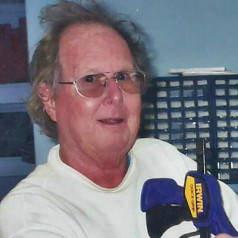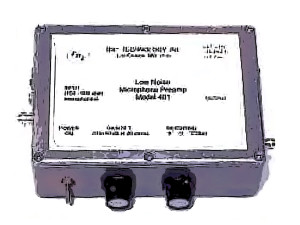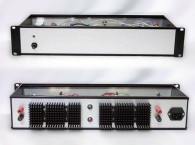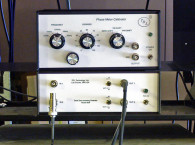
- on Project Articles
- Article
TDL Model 401 Microphone Preamp Review
Anyone looking for a high performance microphone preamp would want to consider this new model from TDL. It is designed to provide very low noise when used with today's high quality sound cards, but can also be used for outdoor work because if its pair of internal rechargeable 9 volt batteries. That aspect of use was what intrigued me about the Model 401.
According to the spec sheet, "With a dynamic range of nearly 70 dB at the full gain of 60 dB," the dynamic range increases with lower gain settings, "96 dB at 40 dB gain, and over 100 dB at 20 dB gain." Gain is selectable in 4 dB steps on a rotary switch on the left side of the front panel. The other knob selects A, B, and C response curves, the latter flat, and the others introducing two stages of bass rolloff.
Inputs are on the left front side, BNC, and mini-plug unbalanced and XLR balanced. However, the latter is unbalanced immediately, pin 3 shorted through a resistor to ground; this may be a concern with some microphones. It is also the wrong sex, being male instead of female, which with any normal microphone cable will require an adaptor. Maybe designer Ron Tipton of TDL isn't into live recording.
The reason is that this is not a balanced circuit design, underscored by the BNC and mono miniplug outputs (2 401's will be needed for stereo use; however, TDL has just introduced a compact battery-operated stereo phono preamp in an identical box, so there may be hope for a similar stereo mike preamp.)
Though the mike preamp can be operated off the batteries (and this is recommended for lowest noise), it can also run directly off the wall-wart charging power supply. It can also be left on all the time without battery overcharge.
The circuit uses paired transistors for gain, and low noise resistors in between each pair to control gain in 9 steps from 20 to 60 dB. These are followed by the final opamp, and the filtering and switching stages. There is also a 25 kHz lowpass filter to eliminate possible aliasing with ADCs in computer sound cards or digital recorders.
The User Manual of the TDL Model 401 is just about the closest thing I've seen to a DIY guide, with complete circuit descriptions and rationale, and circuit schematic diagrams, circuit board pictures, and a complete parts list. However, anyone building one of these from scratch would probably be working at a fraction of any jurisdiction's minimum wage after the many hours of procurement and construction, and probably would not have as neat a box and circuit as you get with the completely assembled 401.
 I tested it with a pair of microphones, a Sony F-99S inexpensive dynamic microphone and an AKG C522 ENG professional condenser mike, feeding one channel through the 401 and recording this on both channels of a DAT recorder. I checked out the low-cut options, and found the 2nd acceptable, but the 1st (position 1 on the rotary switch) too dry. Flat was very natural and had very clean highs, and sounded to me at the middle settings, say 30-to-40-dB gain, excellent in fidelity with very low noise. If I were working with much lower output mikes (and you're not likely to, since most of these require phantom power, anyway), I'd use a preamp like the Bryston BMP-2 which does offer phantom power and has astonishing dynamic range, but costs 10 times the price of this preamp (if you can still get one).
I tested it with a pair of microphones, a Sony F-99S inexpensive dynamic microphone and an AKG C522 ENG professional condenser mike, feeding one channel through the 401 and recording this on both channels of a DAT recorder. I checked out the low-cut options, and found the 2nd acceptable, but the 1st (position 1 on the rotary switch) too dry. Flat was very natural and had very clean highs, and sounded to me at the middle settings, say 30-to-40-dB gain, excellent in fidelity with very low noise. If I were working with much lower output mikes (and you're not likely to, since most of these require phantom power, anyway), I'd use a preamp like the Bryston BMP-2 which does offer phantom power and has astonishing dynamic range, but costs 10 times the price of this preamp (if you can still get one).
I was hoping designer Ron Tipton would offer a stereo version in the same box, with a doubled up power supply for longer battery life, and if he does, I'll definitely buy it for outdoor recording. And he's actually done that.
But if you want to do high quality music recording on your computer at a bargain price, especially with a virtual multichannel desk built into the system, these preamps are very much worth considering, in onesies, or whateversies. They'll likely be better that those offered inside the computer, especially in terms of noise and distortion. And for portable work the TDL Model 401 could be a godsend, especially in a stereo version.
Ron's response
Many thanks to Mr. Marshall for his generally fair review and for the time he spent doing the testing and writing.
There are a few points we would like to clarify.
1. The 'C' or flat frequency response is usually used for music recording. We included the 'A' and 'B' responses for sound level measurements that use these weightings.
2. We now use female XLR connectors on the inputs of all our mic preamps, sorry about that oversight!
3. The input connector of the unit sent for evaluation was wired incorrectly. The input using the XLR connector is now balanced.
4. The gain control rotary switch has 10 steps of 4 dB each to cover the gain range of 20 to 60 dB.
Anyone looking for a high performance microphone preamp would want to consider this new model from TDL. It is designed to provide very low noise when used with today's high quality sound cards, but can also be used for outdoor work because if its pair of internal rechargeable 9 volt batteries. That aspect of use was what intrigued me about the Model 401.
According to the spec sheet, "With a dynamic range of nearly 70 dB at the full gain of 60 dB," the dynamic range increases with lower gain settings, "96 dB at 40 dB gain, and over 100 dB at 20 dB gain." Gain is selectable in 4 dB steps on a rotary switch on the left side of the front panel. The other knob selects A, B, and C response curves, the latter flat, and the others introducing two stages of bass rolloff.
Inputs are on the left front side, BNC, and mini-plug unbalanced and XLR balanced. However, the latter is unbalanced immediately, pin 3 shorted through a resistor to ground; this may be a concern with some microphones. It is also the wrong sex, being male instead of female, which with any normal microphone cable will require an adaptor. Maybe designer Ron Tipton of TDL isn't into live recording.
The reason is that this is not a balanced circuit design, underscored by the BNC and mono miniplug outputs (2 401's will be needed for stereo use; however, TDL has just introduced a compact battery-operated stereo phono preamp in an identical box, so there may be hope for a similar stereo mike preamp.)
Though the mike preamp can be operated off the batteries (and this is recommended for lowest noise), it can also run directly off the wall-wart charging power supply. It can also be left on all the time without battery overcharge.
The circuit uses paired transistors for gain, and low noise resistors in between each pair to control gain in 9 steps from 20 to 60 dB. These are followed by the final opamp, and the filtering and switching stages. There is also a 25 kHz lowpass filter to eliminate possible aliasing with ADCs in computer sound cards or digital recorders.
The User Manual of the TDL Model 401 is just about the closest thing I've seen to a DIY guide, with complete circuit descriptions and rationale, and circuit schematic diagrams, circuit board pictures, and a complete parts list. However, anyone building one of these from scratch would probably be working at a fraction of any jurisdiction's minimum wage after the many hours of procurement and construction, and probably would not have as neat a box and circuit as you get with the completely assembled 401.
 I tested it with a pair of microphones, a Sony F-99S inexpensive dynamic microphone and an AKG C522 ENG professional condenser mike, feeding one channel through the 401 and recording this on both channels of a DAT recorder. I checked out the low-cut options, and found the 2nd acceptable, but the 1st (position 1 on the rotary switch) too dry. Flat was very natural and had very clean highs, and sounded to me at the middle settings, say 30-to-40-dB gain, excellent in fidelity with very low noise. If I were working with much lower output mikes (and you're not likely to, since most of these require phantom power, anyway), I'd use a preamp like the Bryston BMP-2 which does offer phantom power and has astonishing dynamic range, but costs 10 times the price of this preamp (if you can still get one).
I tested it with a pair of microphones, a Sony F-99S inexpensive dynamic microphone and an AKG C522 ENG professional condenser mike, feeding one channel through the 401 and recording this on both channels of a DAT recorder. I checked out the low-cut options, and found the 2nd acceptable, but the 1st (position 1 on the rotary switch) too dry. Flat was very natural and had very clean highs, and sounded to me at the middle settings, say 30-to-40-dB gain, excellent in fidelity with very low noise. If I were working with much lower output mikes (and you're not likely to, since most of these require phantom power, anyway), I'd use a preamp like the Bryston BMP-2 which does offer phantom power and has astonishing dynamic range, but costs 10 times the price of this preamp (if you can still get one).I was hoping designer Ron Tipton would offer a stereo version in the same box, with a doubled up power supply for longer battery life, and if he does, I'll definitely buy it for outdoor recording. And he's actually done that.
But if you want to do high quality music recording on your computer at a bargain price, especially with a virtual multichannel desk built into the system, these preamps are very much worth considering, in onesies, or whateversies. They'll likely be better that those offered inside the computer, especially in terms of noise and distortion. And for portable work the TDL Model 401 could be a godsend, especially in a stereo version.
Ron's response
Many thanks to Mr. Marshall for his generally fair review and for the time he spent doing the testing and writing.
There are a few points we would like to clarify.
1. The 'C' or flat frequency response is usually used for music recording. We included the 'A' and 'B' responses for sound level measurements that use these weightings.
2. We now use female XLR connectors on the inputs of all our mic preamps, sorry about that oversight!
3. The input connector of the unit sent for evaluation was wired incorrectly. The input using the XLR connector is now balanced.
4. The gain control rotary switch has 10 steps of 4 dB each to cover the gain range of 20 to 60 dB.





